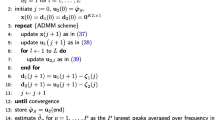Abstract
This paper proposes a method for estimating the direction of arrival (DOA) of multiple source signals for an underdetermined situation, where the number of sources N exceeds the number of sensors M (M < N). Some DOA estimation methods have already been proposed for underdetermined cases. However, since most of them restrict their microphone array arrangements, their DOA estimation ability is limited to a 2-dimensional plane. To deal with an underdetermined case where sources are distributed arbitrarily, we propose a method that can employ a 2- or 3-dimensional sensor array. Our new method employs the source sparseness assumption to handle an underdetermined case. Our formulation with the sensor coordinate vectors allows us to employ arbitrarily arranged sensors easily. We obtained promising experimental results for 2-dimensionally distributed sensors and sources 3×4, 3×5 (#sensors × #speech sources), and for 3-dimensional case with 4×5 in a room (reverberation time (RT) of 120 ms). We also investigate the DOA estimation performance under several reverberant conditions.








Similar content being viewed by others
References
Pillai, S. U. (1989). Array signal processing. New York: Springer.
Brandstein, M., & Ward, D. (Eds.) (2001). Microphone arrays. New York: Springer.
Van Trees, H. L. (Ed.) (2002). Optimum array processing. New York: Wiley.
Schmidt, R. O. (1986). Multiple emitter location and signal parameter estimation. IEEE Transactions on Antennas and Propagation 34, 276–280.
Sawada, H., Mukai, R., Araki, S., & Makino, S. (2005). Frequency-domain blind source separation. In Benesty, J., Makino, S., Chen, J. (Eds.), Speech enhancement pp. 299–327. New York: Springer.
Sawada, H., Mukai, R., Araki, S., & Makino, S. (2005). Multiple source localization using independent component analysis. In Proc. AP-S/URSI2005.
Lombard, A., Rosenkranz, T., Buchner, H., & Kellermann, W. (2008). Exploiting the self-steering capability of blind source separation to localize two or more sound sources in adverse environments. In Proc. ITG conference on speech communication.
Yılmaz, Ö., & Rickard, S. (2004). Blind separation of speech mixtures via time-frequency masking. IEEE Transactions on SP 52(7), 1830–1847.
Bofill, P., & Zibulevsky, M. (2000). Blind separation of more sources than mixtures using sparsity of their short-time Fourier transform. In Proc. ICA2000 (pp. 87–92).
Araki, S., Sawada, H., Mukai, R., & Makino, S. (2005). A novel blind source separation method with observation vector clustering. In Proc. 2005 international workshop on acoustic echo and noise control (IWAENC 2005) (pp. 117–120).
Araki, S., Sawada, H., Mukai, R., & Makino, S. (2007). Underdetermined blind sparse source separation for arbitrarily arranged multiple sensors. Signal Processing 87, 1833–1847.
Zhang, Y., Mu, W., & Amin, M. G. (1999). Maximum-likelihood methods for array processing based on time-frequency distributions. In Proc. SPIE (Vol. 3807, 502–513).
Zhang, Y., Mu, W., & Amin, M. G. (2000). Time-frequency maximum likelihood methods for direction finding. Journal of the Franklin Institute 337(4), 483–497.
Burintramart, S., Sarkar, T. K., Zhang, Y., & Salazar-Palma, M. (2007). Nonconventional least squares optimization for DOA estimation. IEEE Transactions on Antennas and Propagation 55(3), 707–714.
Rickard, S., & Dietrich, F (2000). DOA estimation of many W-disjoint orthogonal sources from two mixtures using DUET. In: Proc. SSAP2000 (pp. 311–314).
Shamsunder, S., & Giannakis, G. B. (1993). Modeling of non-Gaussian array data using cumulants: DOA estimation of more sources with less sensors. Signal Processing 30, 279–297.
Mitianoudis, N., & Stathaki, T. (2007). Batch and online underdetermined source separation using Laplacian mixture model. IEEE Transactions on Audio, Speech, and Language Processing 15(6), 1818–1832.
Matsuo, M., Hioka, Y., & Hamada, N. (2005). Estimating DOA of multiple speech signals by improved histogram mapping method. In Proc. IWAENC2005 (pp. 129–132).
Karbasi, A., Sugiyama, A. (2006). DOA estimation method for an arbitrary triangular microphone arrangement. In Proc. EUSIPCO2006.
Araki, S., Sawada, H., Mukai, R., & Makino, S. (2006). DOA estimation for multiple sparse sources with normalized observation vector clustering. In Proc. ICASSP2006 (pp. 33–36).
Araki, S., Sawada, H., Mukai, R., & Makino, S. (2006). Performance evaluation of sparse source separation and DOA estimation with observation vector clustering in reverberant environments. In Proc. IWAENC2006.
Aoki, M., Okamoto, M., Aoki, S., Matsui, H., Sakurai, T., & Kaneda, Y. (2001). Sound source segregation based on estimating incident angle of each frequency component of input signals acquired by multiple microphones. Acoustical Science and Technology 22, 149–157.
Duda, R. O., Hart, P. E., & Stork, D. G. (2000). Pattern classification, 2nd edn. New York: Wiley Interscience
Mukai, R., Sawada, H., Araki, S., & Makino, S. (2004). Frequency domain blind source separation for many speech signals. In: Proc. ICA 2004. LNCS 3195 (pp. 461–469)
Rickard, S., & Yılmaz, Ö (2002). On the approximate W-disjoint orthogonality of speech. In Proc. ICASSP2002 (Vol. I, pp. 529–532)
ISO 3382 (1997). Acoustics—Measurement of the reverberation time of rooms with reference to other acoustical parameters.
Author information
Authors and Affiliations
Corresponding author
Rights and permissions
About this article
Cite this article
Araki, S., Sawada, H., Mukai, R. et al. DOA Estimation for Multiple Sparse Sources with Arbitrarily Arranged Multiple Sensors. J Sign Process Syst 63, 265–275 (2011). https://doi.org/10.1007/s11265-009-0413-9
Received:
Revised:
Accepted:
Published:
Issue Date:
DOI: https://doi.org/10.1007/s11265-009-0413-9




